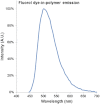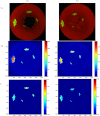Color-matched and fluorescence-labeled esophagus phantom and its applications
- PMID: 23403908
- PMCID: PMC3569733
- DOI: 10.1117/1.JBO.18.2.026020
Color-matched and fluorescence-labeled esophagus phantom and its applications
Abstract
We developed a stable, reproducible three-dimensional optical phantom for the evaluation of a wide-field endoscopic molecular imaging system. This phantom mimicked a human esophagus structure with flexibility to demonstrate body movements. At the same time, realistic visual appearance and diffuse spectral reflectance properties of the tissue were simulated by a color matching methodology. A photostable dye-in-polymer technology was applied to represent biomarker probed "hot-spot" locations. Furthermore, fluorescent target quantification of the phantom was demonstrated using a 1.2 mm ultrathin scanning fiber endoscope with concurrent fluorescence-reflectance imaging.
Figures












Similar articles
-
Target-to-background enhancement in multispectral endoscopy with background autofluorescence mitigation for quantitative molecular imaging.J Biomed Opt. 2014;19(7):76014. doi: 10.1117/1.JBO.19.7.076014. J Biomed Opt. 2014. PMID: 25027002 Free PMC article.
-
Automated coregistered imaging using a hand-held probe-based optical imager.Rev Sci Instrum. 2010 Feb;81(2):023702. doi: 10.1063/1.3271019. Rev Sci Instrum. 2010. PMID: 20192497
-
Comprehensive phantom for interventional fluorescence molecular imaging.J Biomed Opt. 2016 Sep;21(9):091309. doi: 10.1117/1.JBO.21.9.091309. J Biomed Opt. 2016. PMID: 27304578
-
The combined use of fluorescence, reflectance, and light-scattering spectroscopy for evaluating dysplasia in Barrett's esophagus.Gastrointest Endosc Clin N Am. 2004 Jul;14(3):519-37, ix. doi: 10.1016/j.giec.2004.03.008. Gastrointest Endosc Clin N Am. 2004. PMID: 15261200 Review.
-
Characterization of dysplastic tissue morphology and biochemistry in Barrett's esophagus using diffuse reflectance and light scattering spectroscopy.Gastrointest Endosc Clin N Am. 2003 Apr;13(2):297-308. doi: 10.1016/s1052-5157(03)00008-4. Gastrointest Endosc Clin N Am. 2003. PMID: 12916661 Review.
Cited by
-
Target-to-background enhancement in multispectral endoscopy with background autofluorescence mitigation for quantitative molecular imaging.J Biomed Opt. 2014;19(7):76014. doi: 10.1117/1.JBO.19.7.076014. J Biomed Opt. 2014. PMID: 25027002 Free PMC article.
-
Standardization and implementation of fluorescence molecular endoscopy in the clinic.J Biomed Opt. 2022 Feb;27(7):074704. doi: 10.1117/1.JBO.27.7.074704. J Biomed Opt. 2022. PMID: 35170264 Free PMC article.
-
Mapping surgical fields by moving a laser-scanning multimodal scope attached to a robot arm.Proc SPIE Int Soc Opt Eng. 2014 Feb;9036:90362S. doi: 10.1117/12.2044165. Epub 2014 Mar 12. Proc SPIE Int Soc Opt Eng. 2014. PMID: 34321710 Free PMC article.
-
Multimodal laser-based angioscopy for structural, chemical and biological imaging of atherosclerosis.Nat Biomed Eng. 2017;1:0023. doi: 10.1038/s41551-016-0023. Epub 2017 Feb 10. Nat Biomed Eng. 2017. PMID: 28555172 Free PMC article.
-
Toward real-time quantification of fluorescence molecular probes using target/background ratio for guiding biopsy and endoscopic therapy of esophageal neoplasia.J Med Imaging (Bellingham). 2017 Apr;4(2):024502. doi: 10.1117/1.JMI.4.2.024502. Epub 2017 May 24. J Med Imaging (Bellingham). 2017. PMID: 28560244 Free PMC article.
References
Publication types
MeSH terms
Substances
Grants and funding
LinkOut - more resources
Full Text Sources
Other Literature Sources

